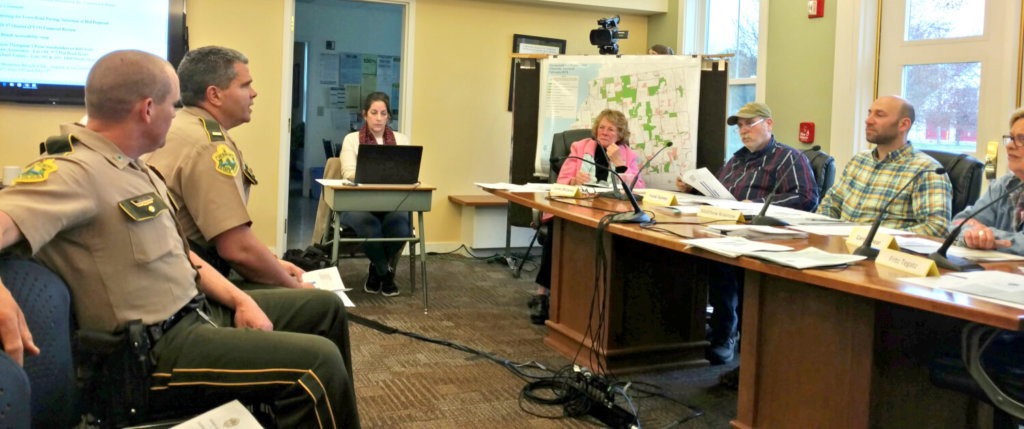State Police update Selectboard

Police and speeding were on the agenda again at the Selectboard meeting Monday night. The schedule allowed for public comment as well as a regularly scheduled biannual review with the Vermont State Police (VSP).
Though speeding is a very real concern for many in Charlotte, the police officers’ report revealed that, at least in one spot, speeding is less of a problem than it appears. Lieutenant Bob Lucas and Sergeant Matt Daley, who is also a Charlotte resident, are the town’s regular contacts with the VSP. They were both at the meeting.
Charlotte has contracted with the VSP since 2015 to patrol Charlotte. This is a common arrangement the State Police make across the state with towns that don’t have their own municipal police departments. For $30,000 a year, VSP provides approximately 32 hours a month of direct patrolling.
The public comment portion of the meeting brought several proponents for lower speed limits in various locations around town that are commonly known as areas where motorists speed. VSP patrols monitor those areas more closely than others.
Megan Price, who lives on Ferry Road and has been a frequent Selectboard meeting attendee and vocal supporter of a 35 mile-per-hour speed limit on her road, said that she was disheartened by a state trooper’s comment in a recent story in The Charlotte News that it was unlikely that the speed limit would change on Ferry. Citing concerns about everything from pedestrians to wildlife safety to texting drivers, she advocated for a speed limit change. “I’m here to lower the speeds before somebody dies,” she said.
Pedestrian safety was a key concern for most who spoke at the meeting, though how to achieve that goal was another matter. Some thought lower speed limits would do the trick, while others asked for signs alerting motorists to bicyclists and pedestrians to help slow traffic.
Margaret Russell, who is on the Charlotte Trails Committee, said she thought it was important to make town-wide policies and changes as opposed to focusing on just a few areas that might be represented by a vocal minority. She also suggested that a different approach be taken instead of increasing police presence in town. “I would much rather see police dollars being spent to make the trails usable and improving pedestrian infrastructure,” she said.
Selectboard Chair Matt Krasnow said the board is open to citizen ideas and that he will add it to the next meeting’s agenda, paying specific attention to “action items that don’t cost a lot of money.” Krasnow praised the work the VSP has been doing in the town, noting that in the five years since they began working with Charlotte, he’s seen positive changes.
In response to the audience complaints, however, Krasnow pointed out that no police agency—in past years, Charlotte has contracted with both Shelburne police and the Chittenden County Sherriff’s department—will allow Charlotte to dictate their hours or which locations in town they cover or to suggest they only enforce certain laws during their patrols.
“You can’t just tell police how to do policing and what’s important,” he said. “If they see an infraction, police can’t turn a blind eye to laws that aren’t being followed, and the town doesn’t have the right to ask them to.”
As far as speeding is concerned, he said, “This is a community issue; it’s not an enforcement issue, and it’s not a structural issue with the roads.”
VSP representatives Lucas and Daley presented data to back up Krasnow’s comment. After receiving feedback from Charlotters that Ferry Road was an area particularly prone to speeders, the VSP placed a speed cart on the road for two weeks to capture data about motorist behavior.
Lucas said that a two-day speed cart placement would result in a dramatic drop in speeders, but that a two-week stint offers a more realistic portrait of traffic speeds in the area. He said that the results from the cart placed on Ferry to troubleshoot after the latest round of complaints were “very surprising.”
He said that he is mindful of and respectful of complaints from residents. “Their perception is reality, and obviously that reality is in their front yard,” Lucas said. Despite the feedback from the community, he said speed cart data revealed that the average speed in the area of the cart was 33 miles per hour, in the 50 mile per hour speed limit zone.
He said the 85th percentile was 46 miles per hour—85 being the key percentage used by the state police to assess whether or not a speed limit should be changed. If 85 percent of motorists are exceeding the speed limit, it usually indicates that the limit should be higher. In this case, it was below the posted limit. Lucas said that there were 5,656 vehicles assessed over the two-week period and that 254 were above the speed limit. “Proportionally, it’s not a huge issue,” he said.
The Selectboard will continue the speeding conversation at its next meeting, Krasnow said.
Mary Anne Ferris, a Lake Road resident, said she disagrees with most and doesn’t think lowering the speed limit to 35 would make a difference. “Most of the speeders that you will see on this road live right there,” she said. “They’re not racing to the ferry.” She did have one suggestion, she said, identifying the problem with a commonly held observation. “I’d like the speed limit to stay right where it is. And I’d like people to learn how to drive.”

